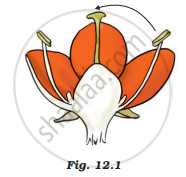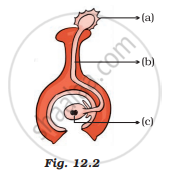Advertisements
Chapters
2: Nutrition in Animals
3: Fibre to Fabric
4: Heat
5: Acids, Bases and Salts
6: Physical and Chemical Changes
7: Weather, Climate and Adaptation of Animals to Climate
8: Wind, Storm and Cyclone
9: Soil
10: Respiration in Organisms
11: Transportation in Animals and Plants
▶ 12: Reproduction in Plants
13: Motion and Time
14: Electric Current and Its Effects
15: Light
16: Water : A Precious Resource
17: Forests : Our Lifeline
18: Wastewater Story
![NCERT Exemplar solutions for Science [English] Class 7 chapter 12 - Reproduction in Plants NCERT Exemplar solutions for Science [English] Class 7 chapter 12 - Reproduction in Plants - Shaalaa.com](/images/science-english-class-7_6:5f2b1b2038084cf381bfa42c826a928c.jpg)
Advertisements
Solutions for Chapter 12: Reproduction in Plants
Below listed, you can find solutions for Chapter 12 of CBSE NCERT Exemplar for Science [English] Class 7.
NCERT Exemplar solutions for Science [English] Class 7 12 Reproduction in Plants MULTIPLE CHOICE QUESTIONS [Pages 62 - 63]
Which of the following parts of a plant take part in sexual reproduction?
(i) Flower
(ii) Seed
(iii) Fruit
(iv) Branch
Choose the correct answer from below.
(i) and (ii)
(i), (ii) and (iii)
(iii) and (iv)
(ii), (iii) and (iv)
Lila observed that a pond with clear water was covered up with a green alga within a week. By which method of reproduction did the algae spread so rapidly?
Budding
Sexual reproduction
Fragmentation
Pollination
Seeds of drumstick and maple are carried long distances by wind because they possess
winged seeds
large and hairy seeds
long and ridged fruits
spiny seeds
The ‘eye’ of the potato plant is what
the root is in any plant.
the bud is a flower.
the bud is to Bryophyllum leaf.
the anther is to the stamen.
The ovaries of different flowers may contain
only one ovule
many ovules
one too many ovules
only two ovules
Which of the following statements is/are true for sexual reproduction in plants?
(i) Plants are obtained from seeds.
(ii) Two plants are always essential.
(iii) Fertilisation can occur only after pollination.
(iv) Only insects are agents of pollination.
Choose from the options given below.
(i) and (iii)
(i) only
(ii) and (iii)
(i) and (iv)
Pollination refers to the
transfer of pollen from another to the ovary.
transfer of male gametes from anther to stigma.
transfer of pollen from anther to the stigma
transfer of pollen from another to the ovule.
NCERT Exemplar solutions for Science [English] Class 7 12 Reproduction in Plants VERY SHORT ANSWER QUESTIONS [Page 63]
Fungus, moss and fern reproduce by a common method of asexual reproduction. Name the method.
Pick the odd one out from the following on the basis of the mode of reproduction and give a reason for it.
Sugarcane, Potato, Rice, Rose
Boojho had the following parts of a rose plant – a leaf, roots, a branch, a flower, a bud and pollen grains. Which of them can be used to grow a new rose plant?
Which type of pollination does Figure 12.1 indicate?

One morning as Paheli strolled in her garden she noticed many small plants which were not there a week ago. She wondered where they had come from as nobody had planted them there. Explain the reason for the growth of these plants.
NCERT Exemplar solutions for Science [English] Class 7 12 Reproduction in Plants SHORT ANSWER QUESTIONS [Pages 63 - 66]
In the diagram given in Figure 12.2 label the parts marked (a), (b) and (c).

When you keep food items like bread and fruits outside for a long time, especially during the rainy season, you will observe a cottony growth on them.
What is this growth called?
When you keep food items like bread and fruits outside for a long time, especially during the rainy season, you will observe a cottony growth on them.
How does the growth take place?
Group the seeds given in Figure12.3 (i) to (iii) according to their means of dispersion.
(a) Seed dispersed by wind
(b) Seed dispersed by water
(c) Seed dispersed by animal

Coconut is a large and heavy fruit. How is it adapted for dispersal by water?
In the figure of a flower given in Figure 12.4, label the parts whose functions are given below and give their names.
(a) The part which contains pollen grains.
(b) The part where the female gamete is formed.
(c) The female reproductive part where pollen grains germinate.
(d) The colourful part of the flower attracts insects.

The male and female gametes fuse to form a _____(a)______ during the process of _____(b)______. This grows into an _____(c)______ which is enclosed within a seed. After fertilisation the ovules develop into _____(d)______ and the ovary develops into a _____(e)______.
In the diagram of a bisexual flower given in Figure 12.5, draw the missing part and label the parts marked (a), (b) and (c). Also, label the missing part that you draw

Write how the following seed is dispersed.
Seeds with wings.
Write how the following seed is dispersed.
Small and light seeds.
Write how the following seed is dispersed.
Seeds with spines/hooks.
Solutions for 12: Reproduction in Plants
![NCERT Exemplar solutions for Science [English] Class 7 chapter 12 - Reproduction in Plants NCERT Exemplar solutions for Science [English] Class 7 chapter 12 - Reproduction in Plants - Shaalaa.com](/images/science-english-class-7_6:5f2b1b2038084cf381bfa42c826a928c.jpg)
NCERT Exemplar solutions for Science [English] Class 7 chapter 12 - Reproduction in Plants
Shaalaa.com has the CBSE Mathematics Science [English] Class 7 CBSE solutions in a manner that help students grasp basic concepts better and faster. The detailed, step-by-step solutions will help you understand the concepts better and clarify any confusion. NCERT Exemplar solutions for Mathematics Science [English] Class 7 CBSE 12 (Reproduction in Plants) include all questions with answers and detailed explanations. This will clear students' doubts about questions and improve their application skills while preparing for board exams.
Further, we at Shaalaa.com provide such solutions so students can prepare for written exams. NCERT Exemplar textbook solutions can be a core help for self-study and provide excellent self-help guidance for students.
Concepts covered in Science [English] Class 7 chapter 12 Reproduction in Plants are Sexual Reproduction in Flowering Plants, Dispersal of Seeds, Reproduction, Mode of Reproduction in Plant, Asexual Reproduction in Plant, Natural Vegetative Reproduction, Pollination, Self Pollination (Autogamy), Cross Pollination, The Seed, Fertilization Process, Fruit, Artificial Vegetative Reproduction.
Using NCERT Exemplar Science [English] Class 7 solutions Reproduction in Plants exercise by students is an easy way to prepare for the exams, as they involve solutions arranged chapter-wise and also page-wise. The questions involved in NCERT Exemplar Solutions are essential questions that can be asked in the final exam. Maximum CBSE Science [English] Class 7 students prefer NCERT Exemplar Textbook Solutions to score more in exams.
Get the free view of Chapter 12, Reproduction in Plants Science [English] Class 7 additional questions for Mathematics Science [English] Class 7 CBSE, and you can use Shaalaa.com to keep it handy for your exam preparation.
